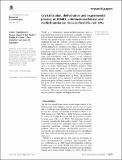Files in this item
Crystallization, dehydration and experimental phasing of WbdD, a bifunctional kinase and methyltransferase from Escherichia coli O9a
Item metadata
| dc.contributor.author | Hagelueken, Gregor | |
| dc.contributor.author | Huang, Hexian | |
| dc.contributor.author | Harlos, Karl | |
| dc.contributor.author | Clarke, Bradley R. | |
| dc.contributor.author | Whitfield, Chris | |
| dc.contributor.author | Naismith, James H. | |
| dc.date.accessioned | 2012-12-14T15:01:03Z | |
| dc.date.available | 2012-12-14T15:01:03Z | |
| dc.date.issued | 2012-10 | |
| dc.identifier | 34631228 | |
| dc.identifier | 959d25be-a463-44d0-b1b5-406fea32d85f | |
| dc.identifier | 000308936200012 | |
| dc.identifier | 84866662372 | |
| dc.identifier.citation | Hagelueken , G , Huang , H , Harlos , K , Clarke , B R , Whitfield , C & Naismith , J H 2012 , ' Crystallization, dehydration and experimental phasing of WbdD, a bifunctional kinase and methyltransferase from Escherichia coli O9a ' , Acta Crystallographica. Section D, Biological crystallography , vol. 68 , no. 10 , pp. 1371-1379 . https://doi.org/10.1107/S0907444912029599 | en |
| dc.identifier.issn | 0907-4449 | |
| dc.identifier.uri | https://hdl.handle.net/10023/3298 | |
| dc.description.abstract | WbdD is a bifunctional kinase/methyltransferase that is responsible for regulation of lipopolysaccharide O antigen polysaccharide chain length in Escherichia coli serotype O9a. Solving the crystal structure of this protein proved to be a challenge because the available crystals belonging to space group I23 only diffracted to low resolution (>95% of the crystals diffracted to resolution lower than 4 angstrom and most only to 8 angstrom) and were non-isomorphous, with changes in unit-cell dimensions of greater than 10%. Data from a serendipitously found single native crystal that diffracted to 3.0 angstrom resolution were non-isomorphous with a lower (3.5 angstrom) resolution selenomethionine data set. Here, a strategy for improving poor (3.5 angstrom resolution) initial phases by density modification and cross-crystal averaging with an additional 4.2 angstrom resolution data set to build a crude model of WbdD is desribed. Using this crude model as a mask to cut out the 3.5 angstrom resolution electron density yielded a successful molecular-replacement solution of the 3.0 angstrom resolution data set. The resulting map was used to build a complete model of WbdD. The hydration status of individual crystals appears to underpin the variable diffraction quality of WbdD crystals. After the initial structure had been solved, methods to control the hydration status of WbdD were developed and it was thus possible to routinely obtain high-resolution diffraction (to better than 2.5 angstrom resolution). This novel and facile crystal-dehydration protocol may be useful for similar challenging situations. | |
| dc.format.extent | 9 | |
| dc.format.extent | 2593481 | |
| dc.language.iso | eng | |
| dc.relation.ispartof | Acta Crystallographica. Section D, Biological crystallography | en |
| dc.subject | WbdD | en |
| dc.subject | Crystal dehydration | en |
| dc.subject | QD Chemistry | en |
| dc.subject.lcc | QD | en |
| dc.title | Crystallization, dehydration and experimental phasing of WbdD, a bifunctional kinase and methyltransferase from Escherichia coli O9a | en |
| dc.type | Journal article | en |
| dc.contributor.sponsor | The Wellcome Trust | en |
| dc.contributor.institution | University of St Andrews. School of Chemistry | en |
| dc.contributor.institution | University of St Andrews. Biomedical Sciences Research Complex | en |
| dc.contributor.institution | University of St Andrews. EaSTCHEM | en |
| dc.identifier.doi | 10.1107/S0907444912029599 | |
| dc.description.status | Peer reviewed | en |
| dc.identifier.grantnumber | 081862/Z/06/Z | en |
This item appears in the following Collection(s)
Items in the St Andrews Research Repository are protected by copyright, with all rights reserved, unless otherwise indicated.

